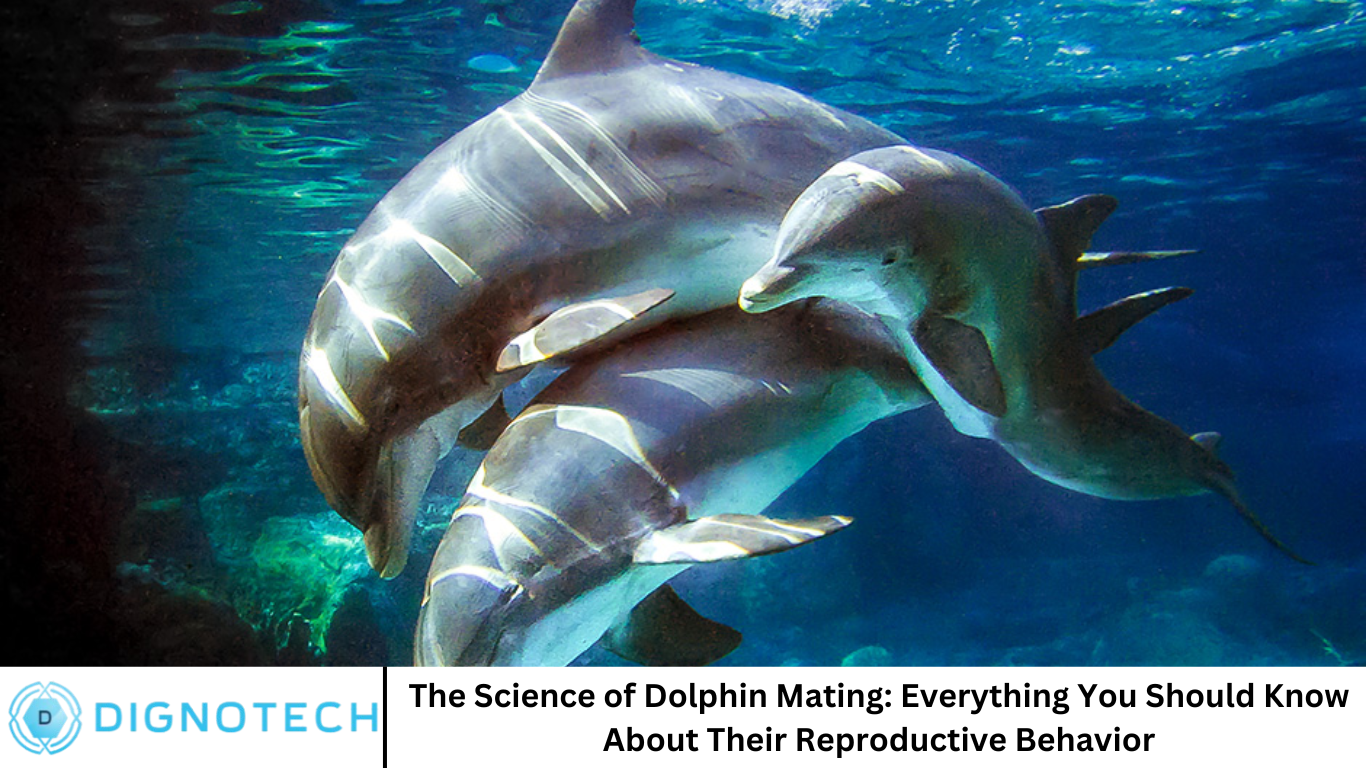The Science of Dolphin Mating: Everything You Should Know About Their Reproductive Behavior

Hi everyone! How are you all doing? Welcome to dignotech.com! Dolphins, known for their intelligence and social complexity, are one of the most intriguing creatures in the animal kingdom. Their mating behaviors are particularly fascinating, as they showcase a combination of advanced social interaction, reproductive strategies, and even emotional bonds. Dolphins engage in a variety of reproductive and mating behaviors that distinguish them from many other animals, making them a subject of scientific curiosity and study.
In this article, we explore the science behind dolphin mating, examining their reproductive anatomy, mating rituals, and the social structures that influence their behavior. Additionally, we’ll address some common questions people have about dolphin sex and reproduction.
Dolphin Reproductive Anatomy
To understand dolphin mating, it’s essential to first look at their reproductive anatomy. Dolphins are mammals, and like all mammals, they have internal fertilization. Here’s a quick breakdown of dolphin reproductive organs:
- Male Dolphins (Bulls): Male dolphins have a penis that is highly flexible and capable of movement in multiple directions. The penis is relatively small compared to their body size but is well-adapted for their aquatic environment. Male dolphins also have testes, which are located near the anus and are capable of producing sperm.
- Female Dolphins (Cows): Female dolphins have two ovaries, from which eggs are released during their reproductive cycles. Their uterus is bifurcated, meaning it is divided into two separate horns. This structure is common in some mammals and is well-suited for the dolphin’s reproductive needs.
- Reproductive Cycle: Female dolphins have a reproductive cycle that is influenced by environmental factors such as water temperature, food availability, and social structure. Most dolphin species, particularly bottlenose dolphins, give birth to a single calf after a gestation period of approximately 10 to 12 months.
Dolphin Mating Systems and Social Structure
Dolphins are social animals, and their mating systems are deeply influenced by their social structures. In most dolphin species, particularly bottlenose dolphins and orcas, males form strong social bonds with other males and sometimes form alliances to compete for mates.
There are two primary types of mating systems in dolphins:
- Promiscuity: Dolphins are often described as sexually promiscuous, engaging in mating behavior with multiple partners. This is particularly true in species like bottlenose dolphins, where males and females have multiple mates during their reproductive years. This promiscuous behavior is believed to ensure genetic diversity within the population and increase the chances of successful reproduction.
- Alliance-Based Mating: In some dolphin species, males form alliances with other males to gain access to females. These alliances are often temporary and can shift, depending on the social structure of the group. Male alliances involve cooperation and competition, with dominant males often securing the best access to females.
Dolphin Mating Behavior and Rituals
Dolphins are highly sexual creatures, and their mating behavior often goes beyond reproduction. Dolphins have been observed engaging in various sexual behaviors, some of which might appear unusual or even “playful” to human observers. However, these behaviors serve specific functions in their social and reproductive lives.
Courtship and Mating Rituals
Dolphin courtship begins with displays of affection and interaction. These can include:
- Chasing and Playful Behavior: Males may chase females in the water, often engaging in playful activities like breaching, splashing, and tail-slapping. This behavior is not only a sign of affection but also a way for males to display their strength and agility, signaling their suitability as a mate.
- Vocalizations: Dolphins use a variety of vocalizations during courtship, including clicks, whistles, and other sounds. These vocalizations help establish communication between potential mates, and research suggests that dolphins can use these sounds to express emotions or intentions during mating.
- Physical Touch: Dolphins are tactile animals, and physical touch plays a significant role in their mating behavior. Males may rub their bodies against females, and females may respond by allowing the males to approach or engage in other forms of physical interaction.
- Male Competition: In cases where multiple males are vying for the same female, competition can be intense. Males will often display aggressive behavior toward one another, such as head-butting, charging, or even engaging in physical fights to establish dominance and gain access to the female.
Copulation
When the female is receptive, the male dolphin will engage in copulation. This typically involves the male mounting the female, which can sometimes be a brief but intense interaction. Dolphins have a relatively quick mating process, with copulation often lasting only a few minutes. However, they may mate several times during a single reproductive cycle.
Homosexual Behavior in Dolphins
One of the most interesting aspects of dolphin mating behavior is their engagement in homosexual activities. Both male and female dolphins have been observed participating in same-sex interactions, which might include genital stimulation, social bonding, and even sexual play.
Homosexual behavior in dolphins is thought to play a role in social bonding, as well as in reinforcing hierarchies within groups. Some researchers also believe that these behaviors are not strictly sexual but serve to reinforce social relationships, build alliances, or reduce tension within the group.
Male dolphins, in particular, are known to engage in homosexual interactions, sometimes as part of an alliance-building process. These behaviors are often observed in species such as bottlenose dolphins, where males form long-term social bonds with other males, sometimes engaging in sexual behaviors as part of their cooperative strategy.
Dolphin Calf Rearing and Parental Care
Once mating occurs and fertilization is successful, the female dolphin will carry the developing fetus for 10 to 12 months. After birth, the female will give birth to a single calf, which is born tail-first to prevent drowning. Calves are born with the ability to swim but rely on their mothers for care and nourishment.
Dolphin mothers are very protective and nurturing of their calves. Calves nurse from their mothers for several months and gradually begin to learn essential survival skills such as hunting and socializing within the group. Dolphins have strong maternal bonds, and the relationship between mother and calf is critical for the calf’s survival.
In some species, such as orcas, other female members of the pod will also assist in rearing the young, creating a strong social structure in which the survival of the young is a collective effort.
The Role of Play in Dolphin Mating
Dolphins are known for their playful behavior, and play is an integral part of their social and reproductive life. Playful behavior is not only about entertainment but also plays a crucial role in learning, socialization, and mating.
Play can include a variety of activities, such as:
- Object Play: Dolphins often play with objects like seaweed, fish, or even human-made objects like boats and nets. This form of play helps dolphins develop coordination and interaction skills, which are important for both hunting and mating.
- Sexual Play: Dolphins engage in sexual play with each other, which can include genital stimulation, chasing, and social interactions. This type of play helps establish social bonds and is thought to play a role in the courtship process.
Why Dolphins Are So Fascinating
The complexity of dolphin mating behavior is one of the many reasons why these animals have fascinated scientists for centuries. Dolphins demonstrate a level of sexual and social sophistication that is rare in the animal kingdom. Their ability to form complex social structures, engage in cooperative behavior, and maintain intricate relationships with one another highlights their intelligence and emotional capacity.
Dolphins also display a variety of behaviors that suggest they have a deep sense of playfulness, social bonding, and even empathy. These characteristics make them one of the most engaging and captivating species to study when it comes to understanding animal behavior and reproduction.
Frequently Asked Question
Do dolphins mate for life?
No, dolphins do not mate for life. They are often promiscuous, and both males and females may have multiple partners throughout their lives. However, some dolphin species, such as orcas, may form long-term social bonds with specific individuals.
How often do dolphins mate?
Dolphins do not have a set mating season, and they can mate year-round. However, the frequency of mating varies depending on the species, the social structure of the pod, and the availability of mates. Female dolphins may only mate when they are in estrus (the period when they are fertile).
Do male dolphins compete for mates?
Yes, male dolphins often compete for mates, especially when multiple males are vying for the same female. Males may form alliances with other males to improve their chances of securing a mate, and they may also engage in aggressive behavior to assert dominance.
Do dolphins engage in homosexual behavior?
Yes, homosexual behavior is common among dolphins, particularly among males. These interactions can include genital stimulation and social bonding, and they are thought to play a role in building alliances and reinforcing social hierarchies within dolphin pods.
How do dolphins care for their calves?
Female dolphins are highly protective of their calves. They provide nourishment through breastfeeding and help their young develop essential skills like hunting and socializing. In some species, other females within the pod assist with calf-rearing, providing a cooperative environment for the young.
Are dolphin mating behaviors influenced by social structure?
Yes, dolphin mating behaviors are strongly influenced by their social structure. Males often form alliances to compete for mates, and the social hierarchy within a pod can affect how mating opportunities are distributed. Females may also choose mates based on their social standing or compatibility with certain males.
Do dolphins have a reproductive season?
Dolphins do not have a strict reproductive season. Instead, their mating and birthing cycles can occur throughout the year, although environmental factors such as water temperature and food availability may influence the timing of reproduction.
Conclusion
Dolphin mating behavior is a complex and fascinating topic that provides insight into the intelligence, social structures, and emotional lives of these remarkable animals. From their promiscuous mating systems to their playful and sometimes homoerotic behaviors, dolphins challenge our understanding of animal sexuality and social interactions. Their behaviors highlight the importance of social bonding, communication, and cooperation in both reproductive and social contexts, making them one of the most unique and captivating species in the animal kingdom.





